Austral islands
Austral islands
The Austral islands guarantee a trip out of time, an immersion in Polynesia, far, very far from the beaten track.
13 days / 12 nights
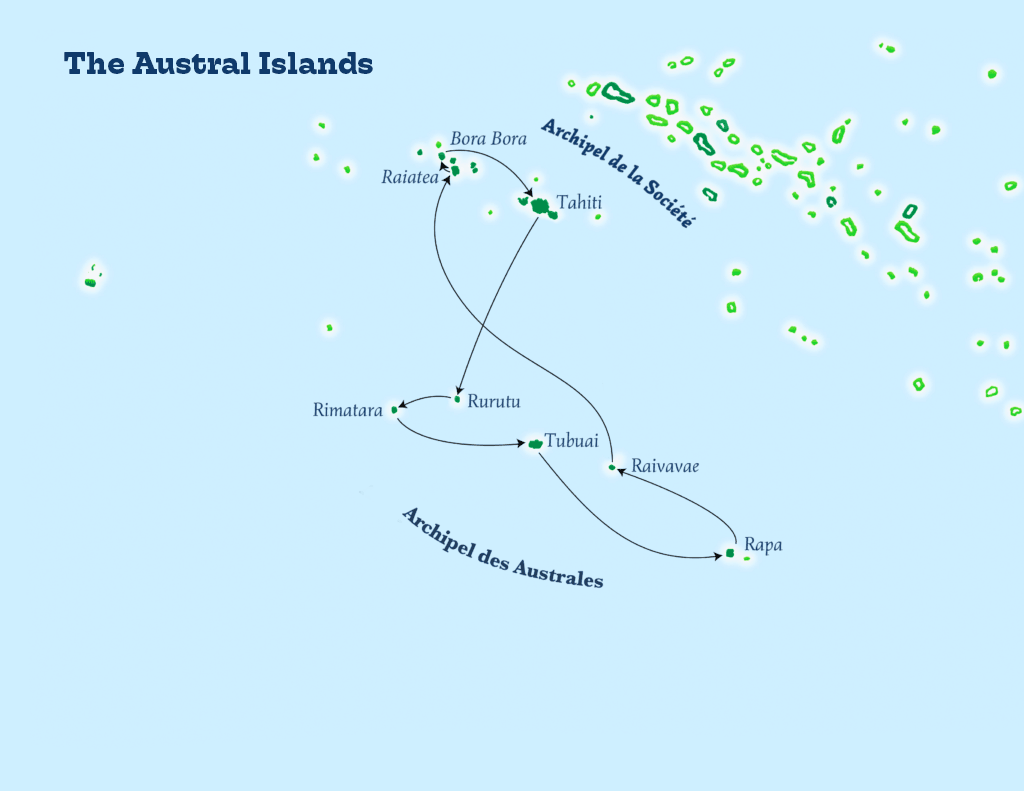
Cruise in the austral islands, the secret archipelagoe
Discovered by Europeans in the 18th Century, the Australs are located 373 miles (600 km) south of Tahiti’s capital city. The archipelago is made of seven islands, five of which are inhabited – Rimatara, Rurutu, Tubuai, Raivavae and Rapa – and four of which are accessible by air. 6,800 people live in the Austral islands, an off the beaten track archipelago of untouched and mysterious land where white sand clashes with the intense blue of the lagoons.
Breath-taking landscapes, from sheer mountains to valleys and high plains, these islands are famous for their farming activities. Several archaeological remains witness to a well organised, pre-European community of rich cultural and religious practices. The cliffs and caves of the Austral Islands were ancient burial grounds and now provide a platform from which visitors can watch Humpback Whales frolic in the water just offshore as they come here from August to October to give birth.
Passengers on board Aranui 5 will take a guided tour of the island’s colourful, picturesque villages and discover the handiwork of islanders who mainly live off their artwork. During their Polynesian cruise they will also enjoy watching fishermen, farmers and basket weavers at work and are unlikely to leave without purchasing a hat or a woven basket to remind them of their magical time in the Austral Islands.
Stopovers
During its cruise to the Austral Islands, Aranui 5 will call at the five main islands of the archipelago.
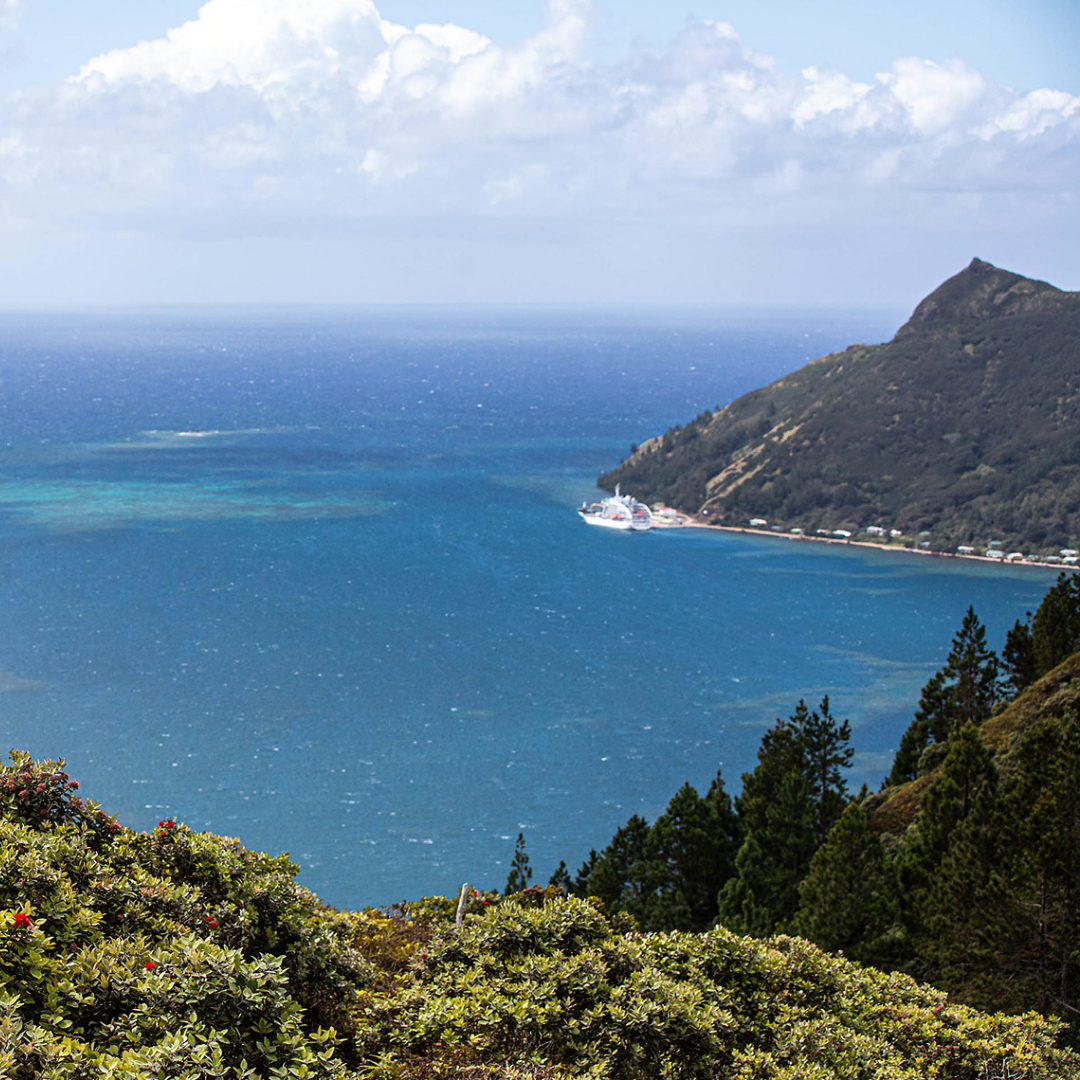
Rapa, the fruit island
Located in the middle of the Pacific Ocean, Rapa Iti is the most isolated and southernmost inhabited island of the Austral archipelago. The particular shape of the island and its remoteness does not allow one to get there by plane: only ships have access. The island is home to a population of 507, described as «the happiest people in the world”. It is so isolated that the inhabitants speak reo rapa, a language that is different from the rest of the Austral Islands. Rapa registers the lowest temperature of the 5 archipelagos: a low of up to 8°C during the dry season (July-August, with records as cold as 4°C). Thanks to this climate, visitors will find a delicious flora, unique in Polynesia: including apples and pear trees, and nectarines… An orchard worthy of the Garden of Eden! As Aranui’s passengers approach Rapa, which is only accessible by sea, the Captain may announce: “Welcome to Rapa. Next stop Antarctica.” As the southernmost inhabited island, this crescent shaped island — with a fjord-like coastline deeply indented by 12 bays —is as remote as it gets in French Polynesia. Rapa-Iti —or “small Rapa”, as the island is also called —has a strong cultural connection to Easter Island, known as Rapa-Nui or big to the Polynesians. Legend tells of the settlement of Rapa-Nui by the people of Rapa-Iti. Once home to fierce warriors who lived in fortified settlements built on terraces among volcanic peaks, the islanders now live more peaceful lives by farming and fishing.
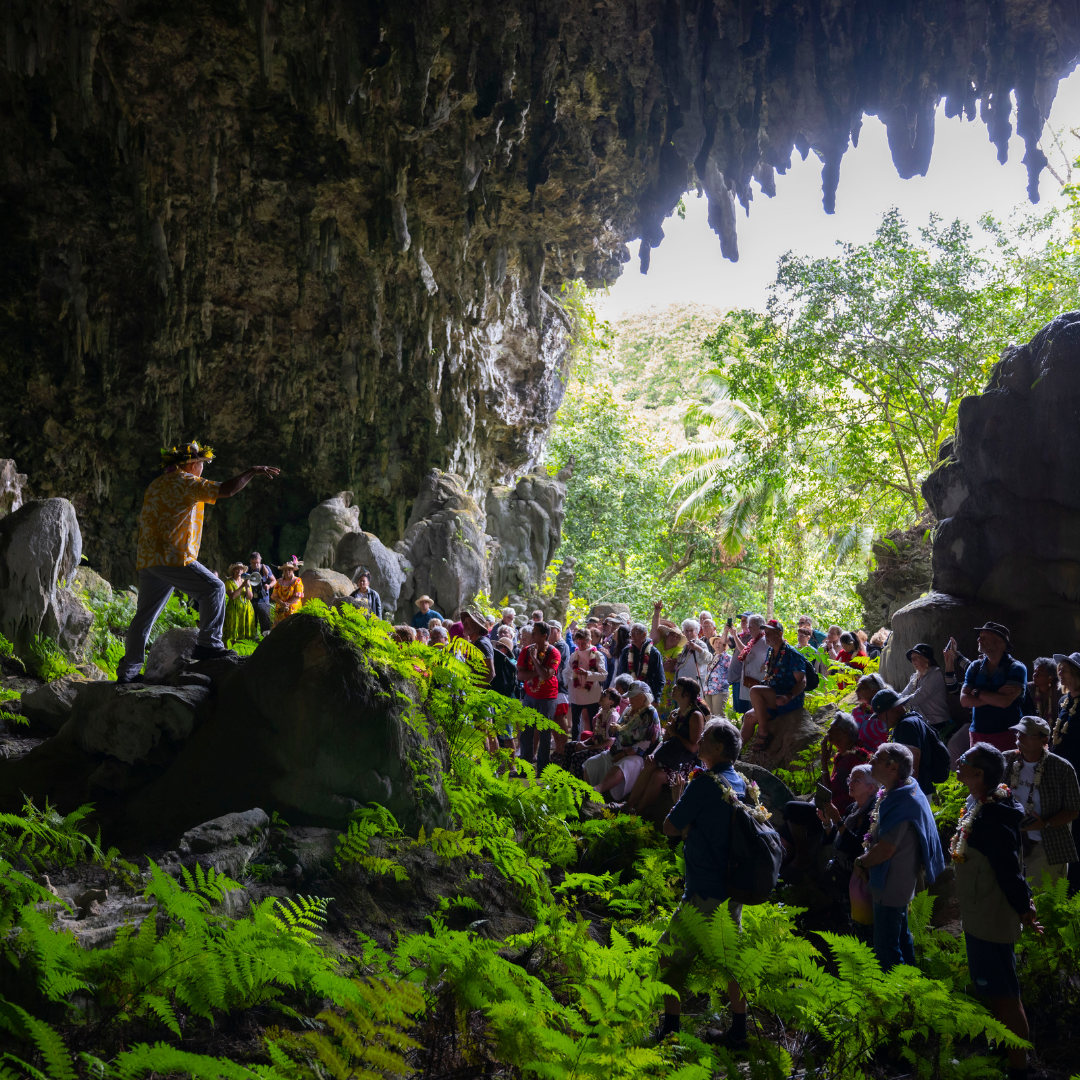
Rurutu, the nothern island of the Austral
The island formation of Rurutu is not what one expects to see in the South Pacific. Its basalt and limestone cliffs are dotted with caves where the islanders once lived close to its white sand beaches and beautiful bays, whilst its volcanic interior hides a lush tropical jungle. Both combining to create stunning visuals for Aranui’s passengers. Archaeological digs have uncovered ancient settlements, council platforms and marae temples in the village of Vitaria, showing man’s presence around 900 A.D. Rurutu is known throughout Polynesia for the exceptionally fine quality of its woven products. From August to October each year, humpback whales can be seen and heard in Rurutu, where they come south to mate and give birth.
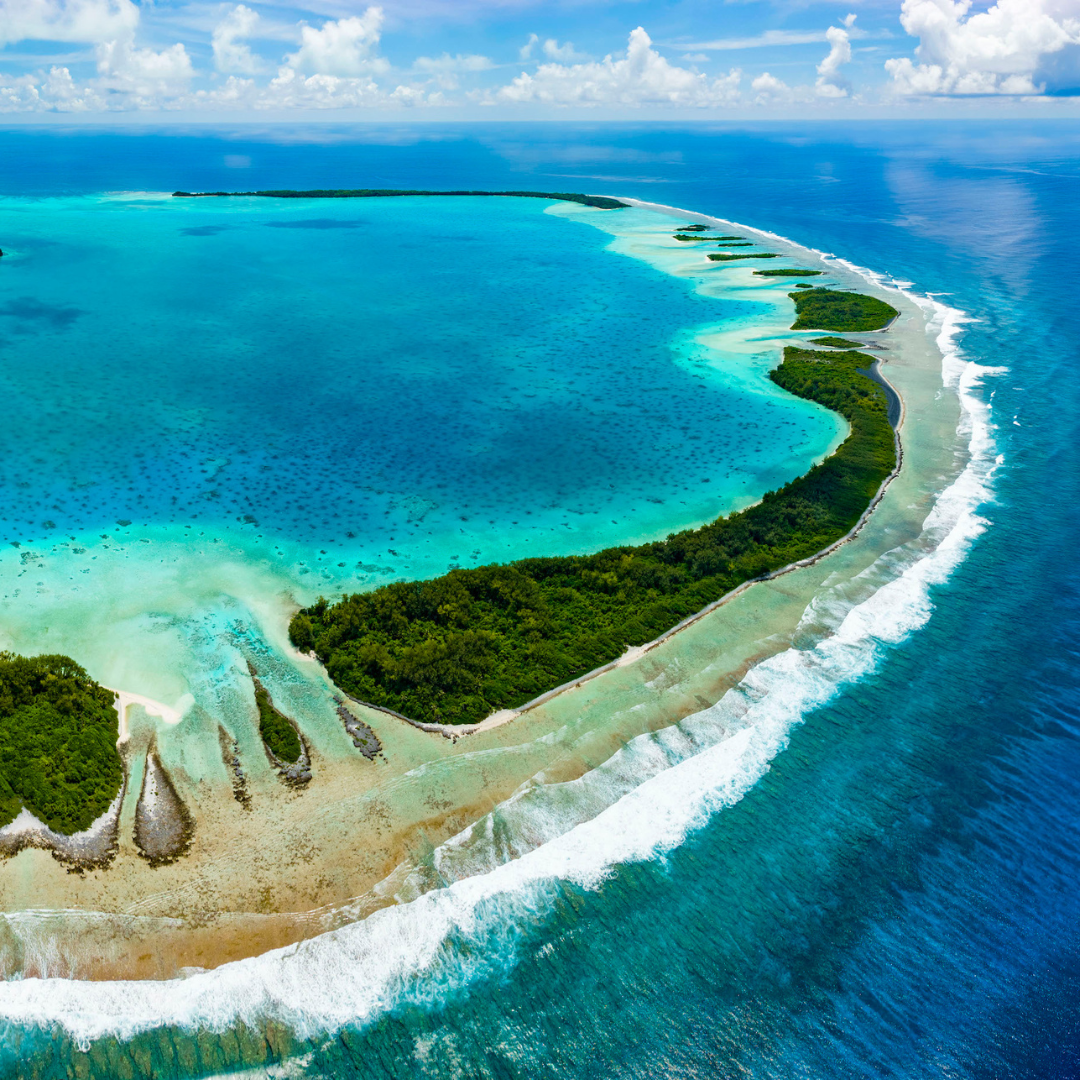
Raivavae, the lagoon island of the Austral Islands
Known as the “Bora Bora of the Austral Islands”, Raivavae’s has earned this distinction of its white sand beaches, with a large emerald lagoon and 28 motus that encircle the lush green main island. The island has a number of giant stone tikis which resemble those found in the Marquesas and on Easter Island, including an unusual smiling tiki. During a circular tour of the island visitors will also discover wood sculptures, an open-air marae temple and a series of Polynesian canoes. After the tour passengers can take a speed boat excursion to relax on one of the motus and swim in the crystal-clear lagoon.

Tubuai, the island of Polynesian crafts
Tubuai is the largest island of this archipelago and hosts the main public and economic services for this island group. Its reef is scattered with fine motu (islands) of coral and volcanic rock. The huge lagoon, nearly twice as large as the island itself, offers 33 sq. mi. (85 km²) of pure aquatic fun. The mild climate also makes these islands ideal for farming. Lilies are grown around the islands for export and can be spotted in the fields as far as the eye can see. The first explorers were struck by the island’s beauty. Toward the end of the 19th Century, explorers Wallis and Cook took a liking to the lush vegetation and crystal-clear water of the island. However, the area did not look appropriate for good anchorage given the large barrier reef around the coast. This disadvantage turned into an incredible advantage in the eyes of the famous mutineers of the HMS Bounty. Led by Christian Fletcher, they built Fort George, which no longer exists, before leaving for Pitcairn.
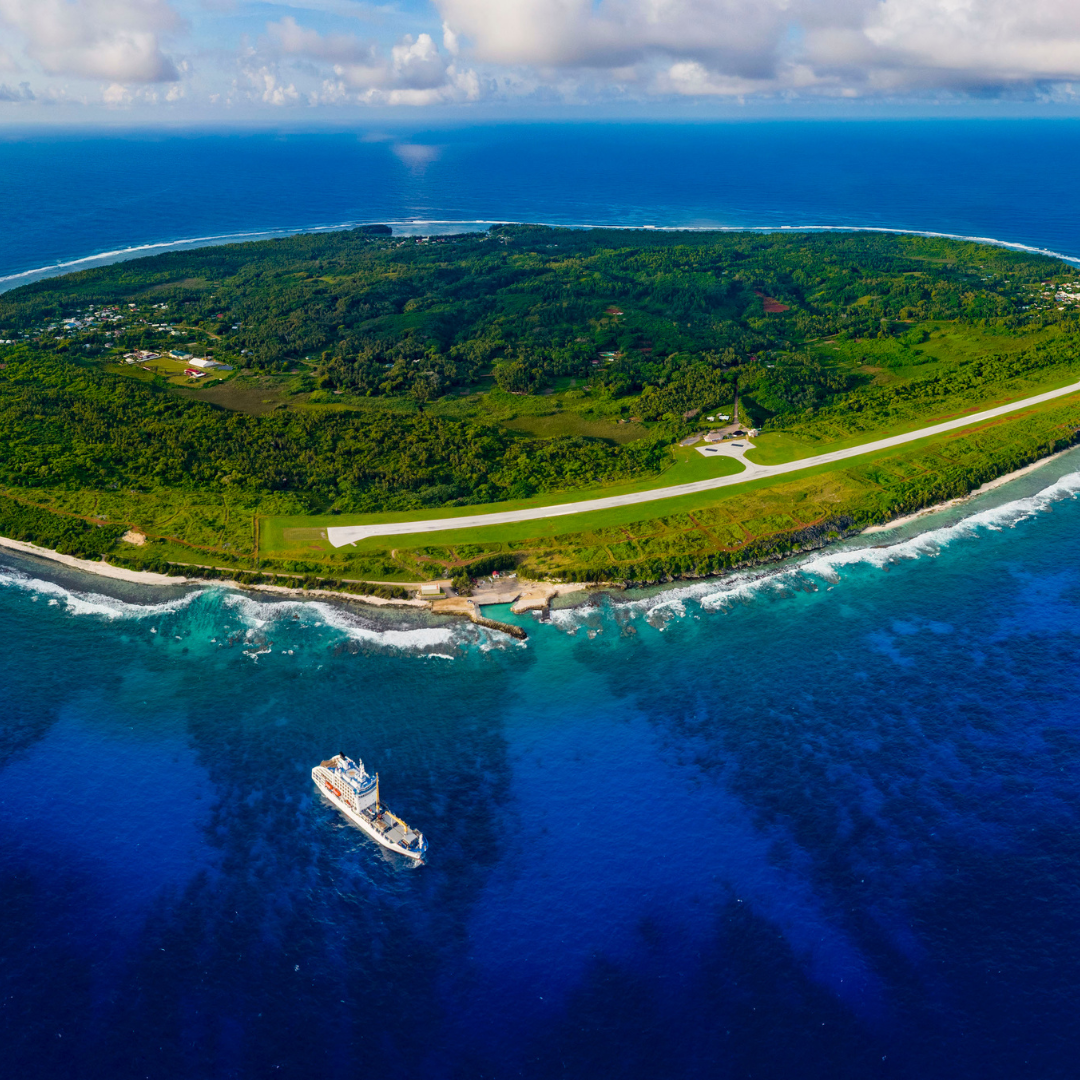
Rimatara, the island of the Lori
Rimatara was the last island of the Australs to be approached, in 1811. The narrowness of its only pass and the absence of an anchorage do not allow easy access, which helped to preserve it. When missionaries were sent to the island in 1821 the 300 inhabitants were all converted quickly. Rimatara was an independent kingdom until 1900, and the royal line of Temaeva ended following the death of the last chief in 1923. At the request of the inhabitants the island was formally annexed to France in 1901. Since then, life flows along to the rhythm of copra, basketry, plantations and fishing. In 2006 the airport was inaugurated, helping to gradually open up this haven of peace and biodiversity. Rimatara takes pride in being the home of a rare specimen of a magnificent endemic bird called the Lori Kuhl, a small colorful parrot.
Itineraries | Schedule | Cabin & Rates
Day 1
Departure from Tahiti (Papeete)
You will embark on the Aranui 5 between 7:00 and 9:00 am in the morning. Departure around 12:00 pm. You will be warmly welcomed by our Polynesian crew and begin the big journey to the Austral Islands.
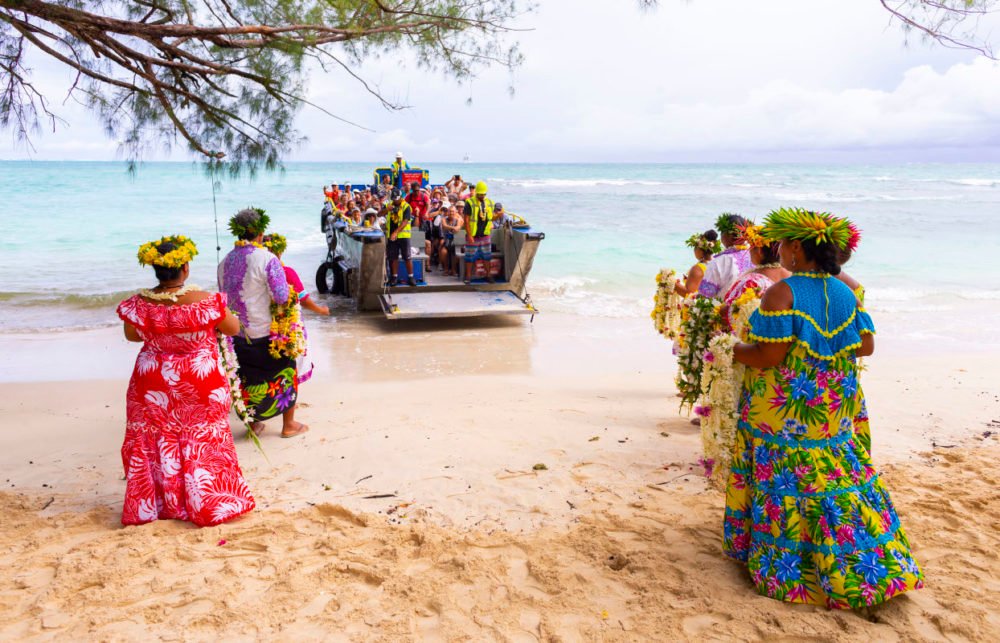
Day 2
Rurutu, Austral Islands
Rurutu, one of the two largest raised atolls in French Polynesia, is unique because of its geological structure which is surprising as one does not expect to discover such landscapes in the South Pacific. Basalt and limestone cliffs dotted with caves where islanders once lived, a volcanic interior with lush tropical jungle, white sand beaches and beautiful bays offer breathtaking views. Rurutu is known throughout Polynesia for the exceptional quality of its basketry, such as beautiful hats, bags and baskets or rugs made of pandanus leaves and other natural materials. The Aranui at anchor, off Rurutu, passengers will disembark, after lunch on board, by tender on the “Moerai”

Day 3
Rurutu, Austral Islands
On the second day, a flower welcome accompanied by Polynesian songs and rhythms on their “ukulele”, guitars and drums will captivate you. Board the trucks, it’s time to visit the wonders of the island. Basalt and limestone cliffs dotted with caves where islanders once lived, lush tropical jungle, white sand beaches and beautiful bays offer breathtaking views. The island’s fertile soil and cooler climate are suitable for growing coffee and taro. A traditional and typical Rurutu meal will be served at the mayor’s house with the opening of the “umu’ai”. Enjoy the white sandy beach of Vitaria and its lagoon. Every year, from August to September, humpback whales can be seen and heard in Rurutu where they come to mate and give birth. The Aranui 5 being there in September, it should be a delight for your eyes and ears. This activity is offered as an option with the visit of the Mole’e cave, nicknamed “the mouth of the monster” for experienced hikers (registration at the reception).
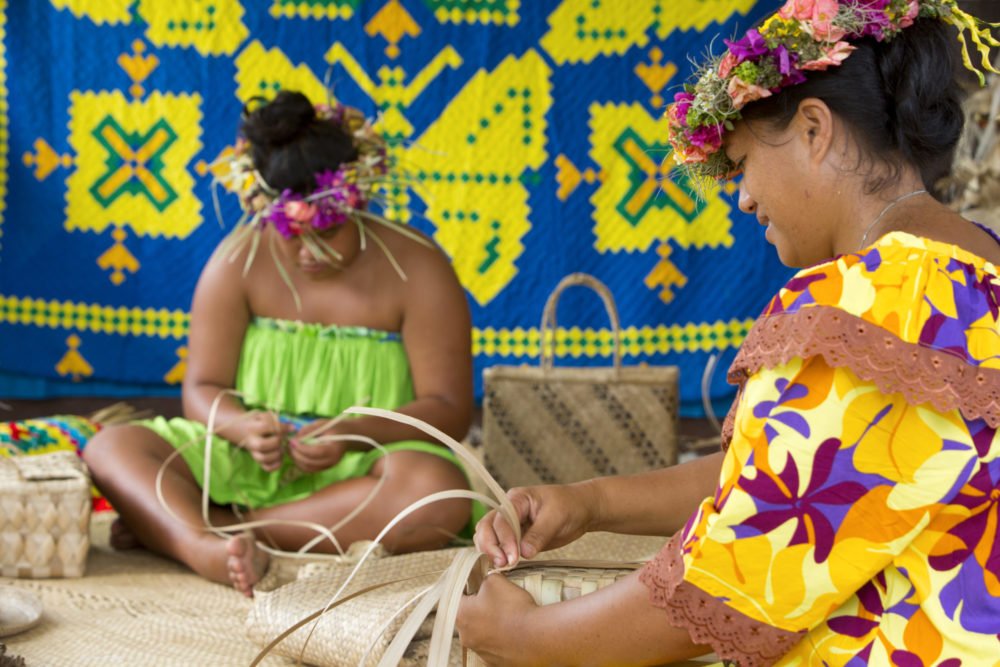
Day 4
Rimatara, Austral Islands
The Aranui disembarks at the “Taanini” dock. A small circular volcanic plateau, Rimatara, the last island of the archipelago to be discovered in the 19th century by Captain Samuel Pinder Henry, has preserved its old traditions, including its own dialect. It is home to an endemic bird, the amazing and colorful Kuhl’s Lori, the “Ura”, which is also found in the Cook Islands.After passing through a purification smoke ceremony, an ancient tradition of welcome, discover the main villages, Amaru, Anapoto and Motuaura by mini-bus or truck. In the old cemetery of Amaru, facing the sea, lies the entire lineage of kings and queens who ruled the island of Rimatara. An old legend says that you should never make faces in front of the royal tomb, otherwise you will remain disfigured for the rest of your life. A barbecue will be served on the beach of Motuaura. Its crystal-clear waters invite you to dive in and discover it with a mask and snorkel. Covered with taro plants and fruit trees, Rimatara is a flower garden with a fresh water well. A bird watching excursion to discover the red parakeet “Ura” is offered as an optional activity (sign-up at the reception).

Day 5
Tubuai, Austral Islands
Tubuai is the most populated island of the Austral Islands. Arriving by tender at the landing stage of Bloody Bay, passengers are welcomed at the town hall with a wreath of flowers, to the sound of local music. You will be able to attend art and craft demonstrations of pandanus leaf weaving and shell necklace making, specific to the island. The island’s fertile soil and cooler climate are ideal for growing cabbage, lettuce, and potatoes. Among the day’s activities: the visit of the cultural sites of the island by truck, the marae of “PO TUI TUI”, Fort George, the first refuge of the mutineers of the Bounty from July to September 1789 and Bloody Bay, witness to the fighting between the islanders and the mutineers. Lunch will be served on board. The beach of Bloody Bay invites you to dive in and discover it with a mask and snorkel.
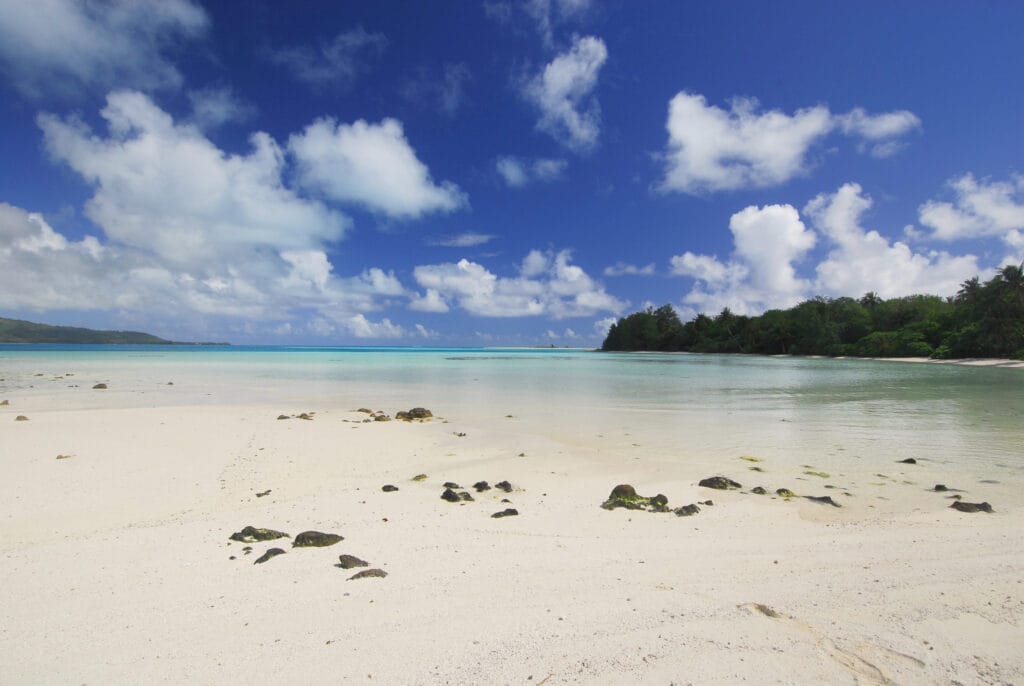
Day 6
At sea
A day to relax on the Pool Deck or in the comfort of our air-conditioned Lounge. Or why not simply enjoy the views of the South Pacific Ocean during our crossing to Rimatara. Lectures on the culture and history of the Austral Islands will give you a complete overview of this civilization. During the cruise, the spirited Polynesian crew will proudly introduce you to their way of life and entertain you with Polynesian songs and rhythms on their “ukulele”, guitars and drums.
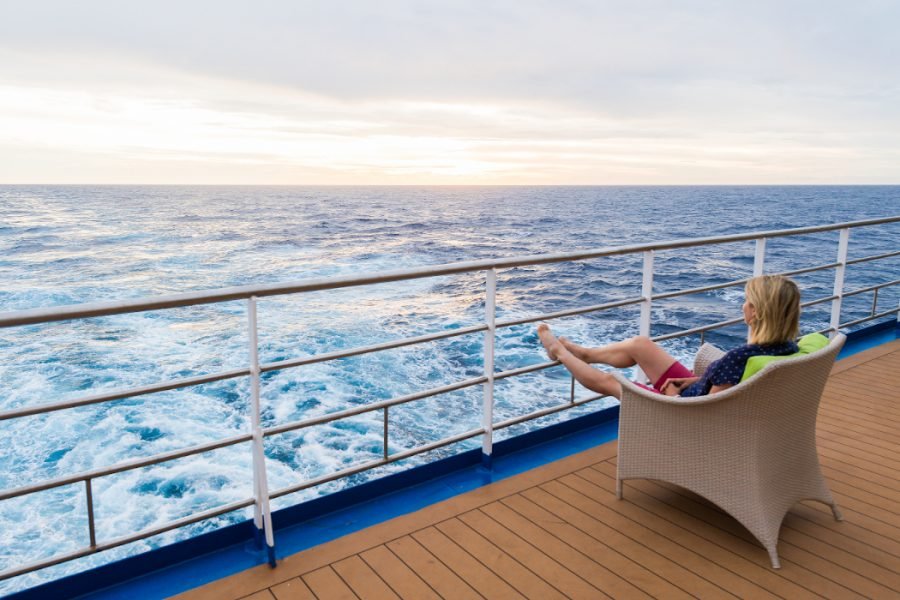
Day 7
Rapa, Austral islands
As you approach Rapa, only accessible by sea, the Captain may announce: “Welcome to Rapa. Next stop Antarctica”. As the southernmost inhabited island of French Polynesia, this crescent shaped land mass — with a fjord-like coastline deeply indented by 12 bays —is as remote as it gets. Rapa is Easter Island’s little sister. It has a temperate climate, no coral or coconut trees, but fruits and vegetables other than tropical ones are plentiful here: apples, peaches, nectarines… The Aranui will disembark at the dock in Ahurei. Passengers will be greeted with flower wreaths, to the typical sounds and rhythms of Rapa. Trucks will be waiting for you, heading to the cultural center. You will discover how the “mamas” make local crafts: hats and baskets made of reed (a fragile material) and bamboo crafts. A local meal will be served on land. On Rapa, we propose a two and a half hour walk to Fort Morango Uta. Polynesian evening with a plancha buffet around the pool (Deck 7) or in the Restaurant (Deck 4) depending on the weather conditions.

Day 8
Rapa, Austral Islands
Among the other activities on offer during our one and a half day stopover in Rapa, you will visit Ahurei, the main village of the island, explore ancient fortresses, visit an agricultural production centre, discover local arts and crafts, meet the inhabitants of this isolated island, and share a ma’a over a wood fire in the village.
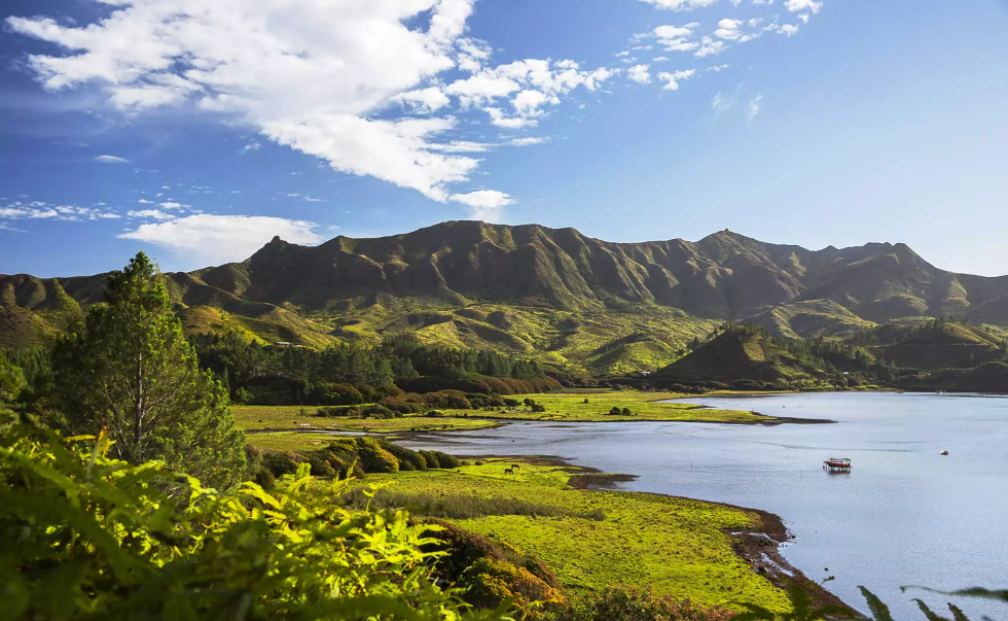
Day 9
Raivavae, Austral Islands
It is said that Raivavae is the “Bora Bora of yesteryear” and that its lagoon is the most beautiful in Tahiti & her islands. A jewel preserved by its inhabitants; the island is a veritable garden of Eden where visitors fall under
her spell. When the Aranui is at anchor, passengers disembark by tender onto Mahanatoa beach where they will be welcomed with wreaths of flowers, to the sound of Raivavae songs and rhythms. Departure by bus for a tour of the island. Do not miss the visit of the “Smiling Tiki” and the marae scattered around the island. Of course, its inhabitants will serve you a typical Raivavae
buffet on Mahanatoa beach. Take advantage of the remaining time to walk around the village or to discover its lush lagoon with a mask and snorkel. The discovery of Mount Hiro will be offered as an option (sign-up at the reception).
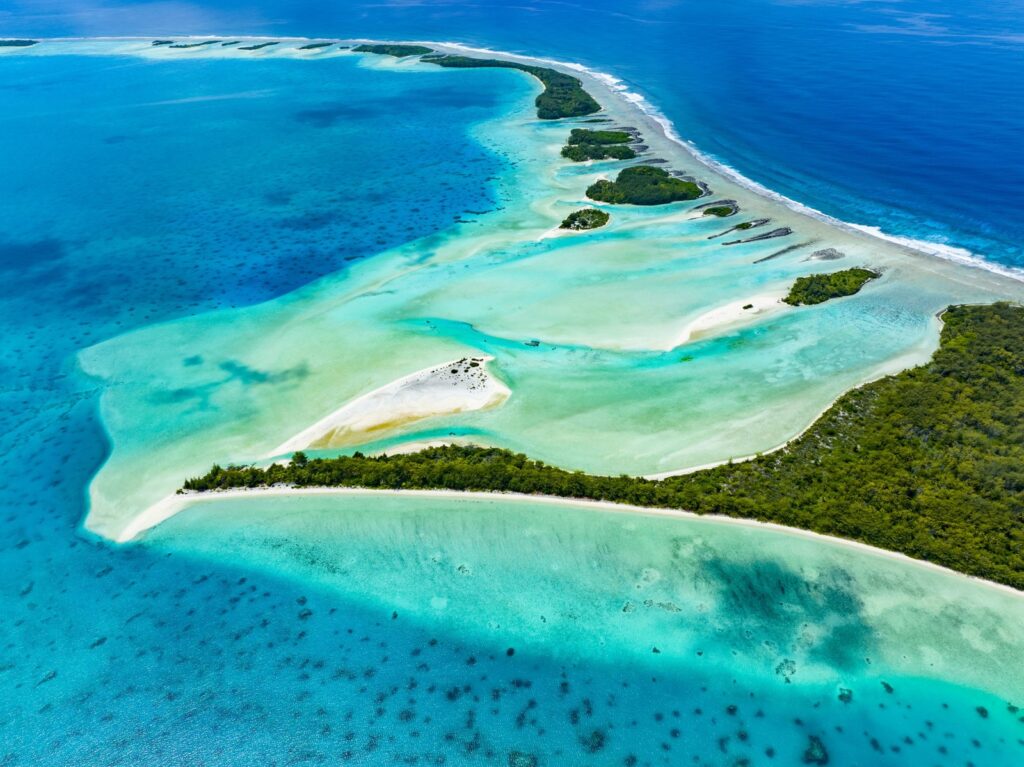
Day 10
At sea
A day to relax on the Pool Deck or in the comfort of our air-conditioned Lounge. Or why not simply enjoy the views of the South Pacific Ocean on our return to the Society Islands. Lectures on the culture and history of the passenger-freighter Aranui 5 will give you a complete overview of the philosophy and valuable contributions made by the company. Faithful to the Polynesian experience, the entertainment remains traditional: initiation to Polynesian songs, Tahitian dance, without forgetting our shows and dances under the stars.
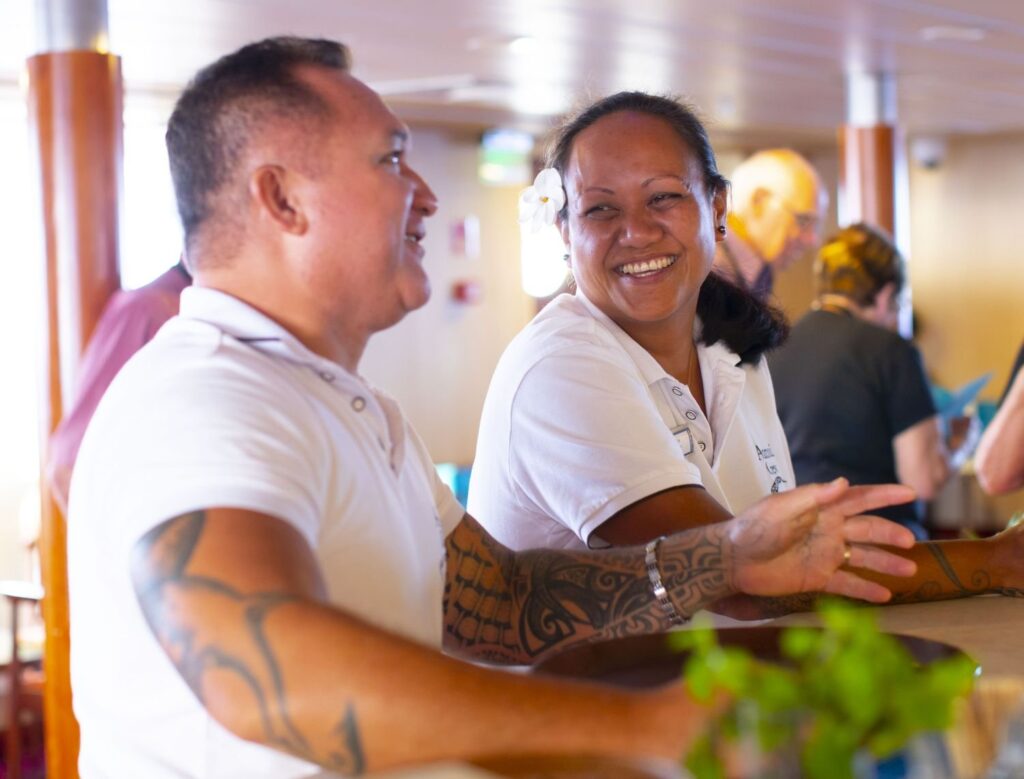
Day 11
Raiatea, Society islands
In the Polynesian triangle, Raiatea, formerly known as Havai’i, is considered the cradle of Polynesian civilization. As the first Polynesian island to be populated by sailors and navigators, it is here that all migrations to the three points of the triangle, New Zealand, Hawaii and Easter Island, began. The Aranui will disembark at the dock, and passengers will be greeted, with a tiare flower, to the sounds of the “to’ere”. Buses will be waiting for you to visit the most spectacular marae in the Polynesian triangle, Taputapuatea, a 1,000-year-old open-air temple now a UNESCO World Heritage Site. It is considered the religious and spiritual center of all Polynesia. After lunch, you will enjoy your afternoon visiting the town of Uturoa, its stores and crafts on the waterfront.

Day 12
Bora Bora, Society islands
As you arrive in Bora Bora’s world-famous lagoon of opalescent blues and greens, you will be greeted by the majestic “Mount Otemannu”, the highest peak on the island. You can enjoy a day at the beach and a barbecue on a private Motu surrounded by crystal clear waters, the “Motu Tapu”. You can also choose from a veriety of option excursions at an additional cost: scuba diving, boat and motorized canoe tours of the lagoon, swimming with sharks and rays! Bora Bora was an American military outpost during World War II and remnants of the war such as cannons and bunkers can be seen on a 4X4 tour. Departure in the evening for Papeete.
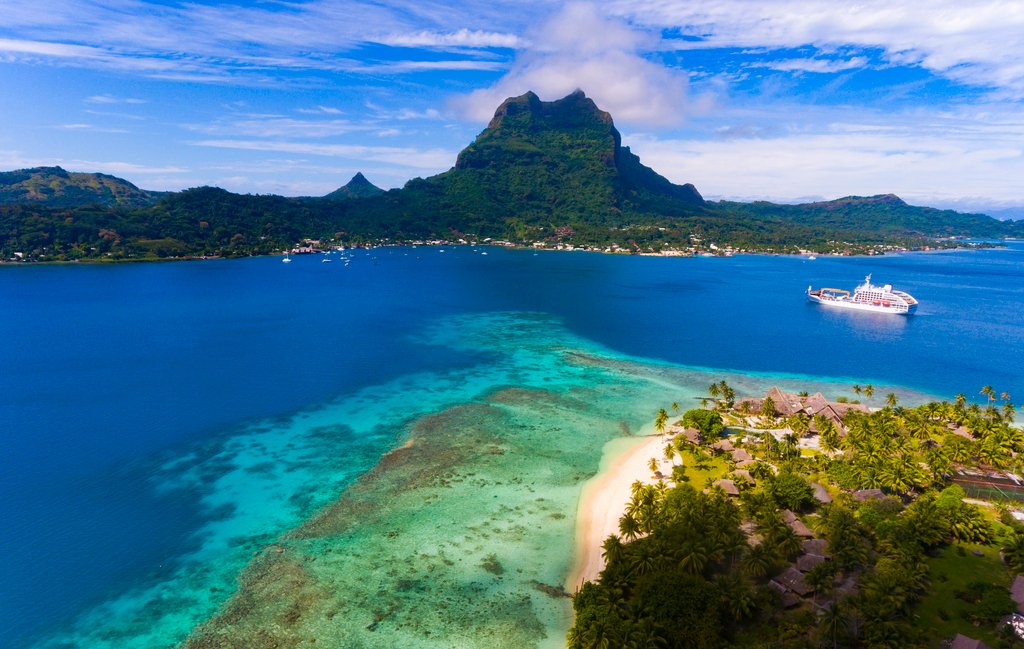
Day 13
Return to Tahiti (Papeete)
This is the end of our journey. It’s time to say Nānā! (Goodbye) to your travel companions, to the Polynesian staff and Aranui guides.
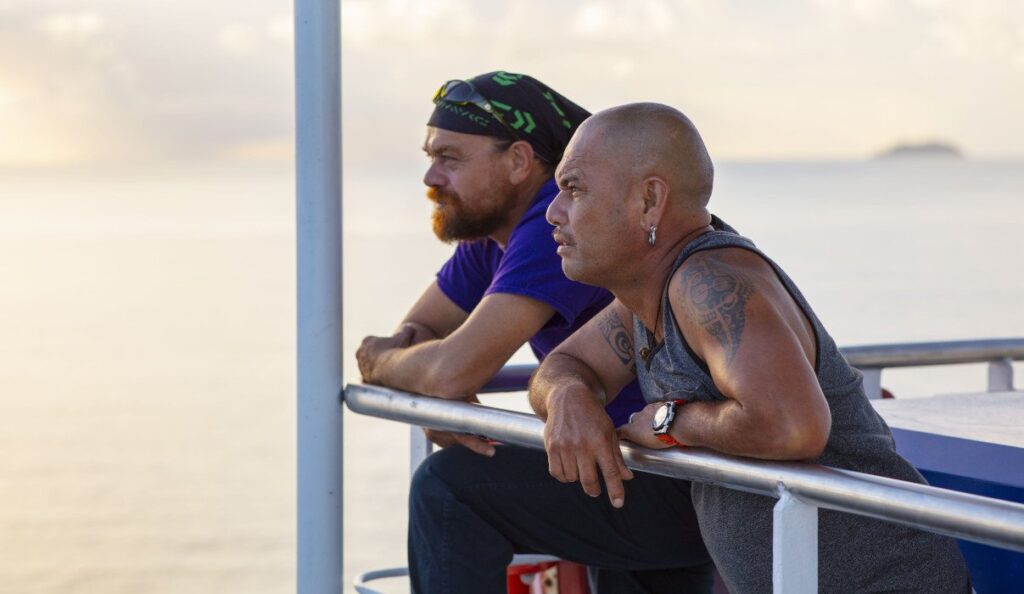
Austral islands - 2025
| Cruise #4 | Saturday 5 April – Thursday 17 April |
| Cruise #15 | Saturday 6 September – Thursday 18 September |
| Cruise #19 | Saturday 1 November – Thursday 13 November |
Austral islands - 2026
| Cruise #3 | Saturday 14 February – Thursday 26 February |
| Cruise #6 | Saturday 28 March – Thursday 9 April |
| Cruise #18 | Saturday 12 September – Thursday 24 September |
| Cruise #21 | Saturday 24 October – Thursday 5 November |
Presidential Suite
- Sky deck - 9
- 41 m²
- 1 to 3 adults
Composed of three individual rooms of 41 m² interior area and a private balcony of 12 m², this outdoor cabin has a separate bedroom with a large double bed, a living room with a sofa bed, a living room with integrated bar, two bathrooms with shower and hairdryer, dressing room, refrigerator and safe.
Double Occupancy
AUD 16,203
price per person
Single Occupancy
AUD 24,021
price per person
Royal suite
- Pool deck - 7, Sun deck - 8
- 22m²
- 1 to 3 adults
This 22 m² outdoor cabin with a 9 m² private balcony features a bedroom with a king-size bed and a living area with a sofa bed, separated by a decorative Polynesian-style partition. The cabin also includes a bathroom with a shower and hair dryer, as well as a refrigerator and safe.
Double Occupancy
AUD 12,837
price per person
Single Occupancy
AUD 18,972
price per person
Royal Suite View Obstructed
- Boat deck - 5
- 22m²
- 1 to 3 adults
This outdoor cabin of 22 m² with private balcony of 9m² has a bedroom with a large double bed and a living room with a sofa bed separated by a decorative partition of Polynesian style, a bathroom with shower and dryer hair, refrigerator and safe.
Double Occupancy
AUD 12,308
price per person
Single Occupancy
AUD 18,178
price per person
Premium Suite
- Pool deck - 7, Veranda deck - 6
- 19m²
- 1 to 3 adults
This outdoor cabin of 19 m² with private balcony of 4m² has a bedroom with a large double bed or twin beds, a living room equipped with a sofa bed, separated by a decorative partition of Polynesian style, a bathroom with shower and dryerhair, refrigerator and safe.
Double Occupancy
AUD 11,763
price per person
Single Occupancy
AUD 17,360
price per person
Junior Suite Without Balcony
- Veranda deck - 6
- 19m²
- 1 to 2 adults
This 19 m² outdoor cabin without balcony but with large windows has a bedroom with a large double bed or twin beds, a bathroom with shower and hairdryer, a refrigerator and a safe.
Double Occupancy
AUD 11,305
price per person
Single Occupancy
AUD 16,674
price per person
Junior Suite With Balcony
- Veranda deck - 7
- 16m²
- 1 to 2 adults
This 16 m² outdoor cabin with a 4 m² balcony has a bedroom with a large double bed or twin beds, a bathroom with shower and hairdryer, a refrigerator and a safe.
Double Occupancy
AUD 11,305
price per person
Single Occupancy
AUD 16,674
price per person
Superior Deluxe
- Sun deck - 8, Main deck - 3, Upper deck - 4, Sky deck - 9
- 15m²
- 1 to 2 adults
This 15 m² outdoor cabin with a private balcony of 4 m² has a bedroom with a large double bed or twin beds, a bathroom with shower and hairdryer, a fridge and a safe.
Double Occupancy
AUD 11,051
price per person
Single Occupancy
AUD 16,293
price per person
Deluxe
- Sky deck - 9, Pool deck - 7, Sun deck - 8
- 13m²
- 1 to 2 adults
This 13 m² outdoor cabin with a private balcony of 4 m² has a bedroom with a large double bed or twin beds, a bathroom with shower and hairdryer, a fridge and a safe.
Double Occupancy
AUD 10,248
price per person
Single Occupancy
AUD 15,089
price per person
Stateroom
- Boat deck - 5, Lower deck - 2, Sun deck - 8, Main deck - 3
- 11m²
- 1 to 2 adults
This 11 m² outdoor cabin with porthole has a large double bed or 2 single beds and a private bathroom with shower and hairdryer.
Double Occupancy
AUD 8,618
price per person
Single Occupancy
AUD 12,644
price per person
Stateroom quadruple
- Lower deck - 2
- 17m²
- 1 to 3 adults
This four-bed cabin, 17 m², has a large double bed, two bunk beds and a private bathroom with shower and hairdryer. The displayed fare applies to the first two occupants of the cabin. The third and fourth occupant benefit from a 25% discount.
Double Occupancy
AUD 8,618
price per person
Single Occupancy
AUD 12,644
price per person
Single Stateroom
- Lower deck - 2
- 9m²
- 1 to 1 adults
This 9 m² cabin with porthole has a single bed and a private bathroom with shower and hairdryer.
Double Occupancy
AUD 11,839
price per person
Single Occupancy
AUD 11,839
price per person
Stateroom Obstructed View
- Lower deck - 5
- 11m²
- 1 to 2 adults
This outdoor cabin of 11 m² with obstructed porthole has a bed in large double bed or 2 single beds, a bathroom with shower and hairdryer.
Double Occupancy
AUD 8,214
price per person
Single Occupancy
AUD 12,037
price per person
Dormitory - class C - 8 beds
- Lower deck - 4
- 27m²
- 1 to 1 adults
This category of dormitory style accommodation has a space of 27 m² with 8 bunk beds, a living room, two bathrooms with shower and hairdryer.
Dormitory - class C - 4 beds
- Lower deck - 4
- 13m²
- 1 to 1 adults
The dormitory has 5 units: four units of 13 m² each that can accommodate four passengers per unit with two lower berths and two upper berths, a bathroom with shower and hairdryer and a 27 m² unit with 8 bunk beds. The 8-bed unit has a living room, two bathrooms with shower and hairdryer. This category can be mixed.
What's included
Rates include
Cruise transportation and related taxes (tourist tax, port tax, fuel, TDC), shipboard accommodation, 3 meals per day, a bottle of wine to share among 4 passengers for scheduled onboard meals, lunches in local restaurants, planned guided shore excursions to remote villages and archaeological sites, cultural dance shows, lecturers onsite and onboard. Rates are per adult, in double or single occupancy. These fares are correct at the time of printing and are subject to change; with or without notice.
Rates do not include
Shipboard purchases, liquor, gratuities, port taxes other than those specifically provided for, and other personal items. Rates quoted at the time of printing are based on current costs and are subject to change up to and including the date of sailing.
Itinerary changes
Routes and activities are indicative and can be modified according to weather conditions or availability. CPTM pledges to make every effort to operate all cruises as advertised. CPTM reserves the right to alter or curtail the itinerary, or substitute sightseeing, ports of call or conveyances as deemed necessary.
Optional excursions
At every port, guests can enjoy included excursions. For a bit more adventure, there are optional activities from which to choose. The optional activities can be booked on board and at an additional cost.


